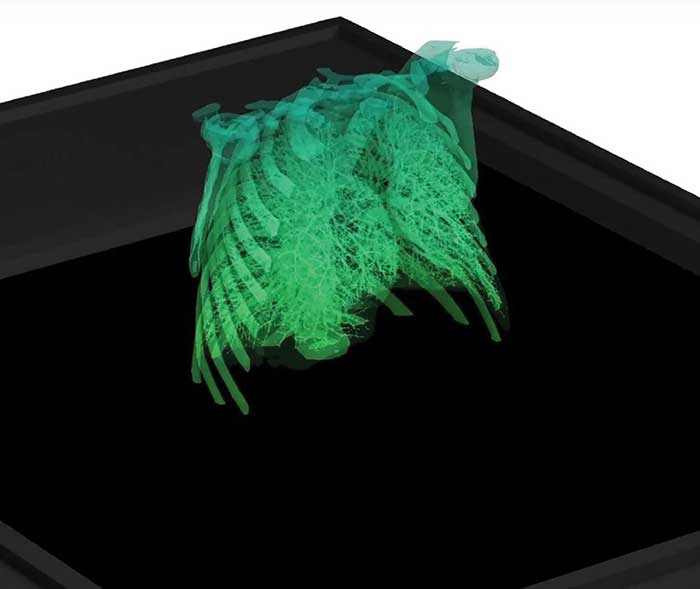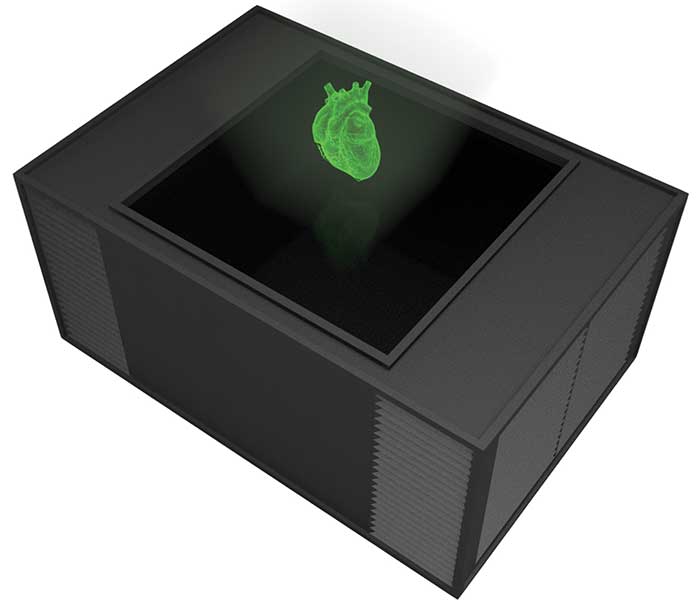
Sci-Fi Holograms Emerge on the Medical Scene
Doctor visits may be a lot more revealing in the next few years thanks to moving 3D video holograms.
Scientists and engineers in the U.K. have introduced a new technology that will allow doctors and patients to see a heart beat, lungs inflate and even an unborn child in life size as a hologram that can be rotated and enlarged in real time.

3D video hologram of a ribcage. These movable dynamic holograms will be available in a few years. Courtesy of Holoxica.
There is no need for 3D specs or a virtual reality headset with the dynamic or moving video third-generation holograms from Holoxica. They are made by gathering multiple slices of an internal organ from a normal CT or MRI scanner. The slices are then put through a diffractive holographic screen, producing single color green pixels or voxels in mid-air. Javid Khan, CEO of Holoxica, told Photonics Media that the process essentially bends light to the will of the user.
“The bending of light is based on a special diffractive optical element that acts like a fast lens,” said Khan. “It is used together with a projector to form images in real space. Other elements of the system include an image processing subsystem and an illumination subsystem.”
Holoxica has teamed up with ACTPHAST — a European photonics innovator accelerator — to produce the gadget often seen on the big screen in science fiction flicks.
“Hollywood depicts holographic displays as something ubiquitous,” said Khan. “This has created inflated expectations in the mind of the public, who largely believe that displays or ‘holographic projectors’ already exist and are trivial to make. This is not the case.”

An interactive holographic video created from an MRI or CT scan that can be rotated, enlarged, and isolated. Courtesy of Holoxica.
Khan and his team started their project with the simplest holographic
display — a single voxel in 3D space — that can be turned on and off.
After the first, they moved on to two voxels, working up to four, then
nine and so on, using photonics design and engineering of diffractive
optical elements to bend or form light to produce images in mid-air.
Khan said there is an absolute need for this technology.
“There is a need for physicians, especially surgeons and consultants, to visualize 3D scans for diagnostics, monitoring and surgical planning,” he said. “It is needed to explain conditions to patients in an intuitive way as well.”
Current visualization is done with 2D images, which prove difficult to interpret. This new technology provides a solution by presenting the 2D images as a “stack of light,” giving users an easier way to interpret complex data.
Augmented and virtual reality are quite popular right now, but Khan said they have limitations that make them unsuitable for a true 3D experience. This is something he and his team of scientists and researchers hope to overcome with their third-generation dynamic display.
“These technologies do not recreate a true 3D image. They present a pair of 2D images to both eyes. Our world is three-dimensional; our brains are wired for three dimensions. Holoxica’s work is spearheading an entirely new Renaissance for our time.”
Khan told Photonics Media they have built a whole series of these displays and aim to have their next prototype ready in a year. They are also working with the automotive industry to put this into high-end cars. Future applications could include consumer gaming.
Look for a true 3D medical experience coming to a doctor’s office near you.
/Buyers_Guide/Holoxica_Ltd/c19652